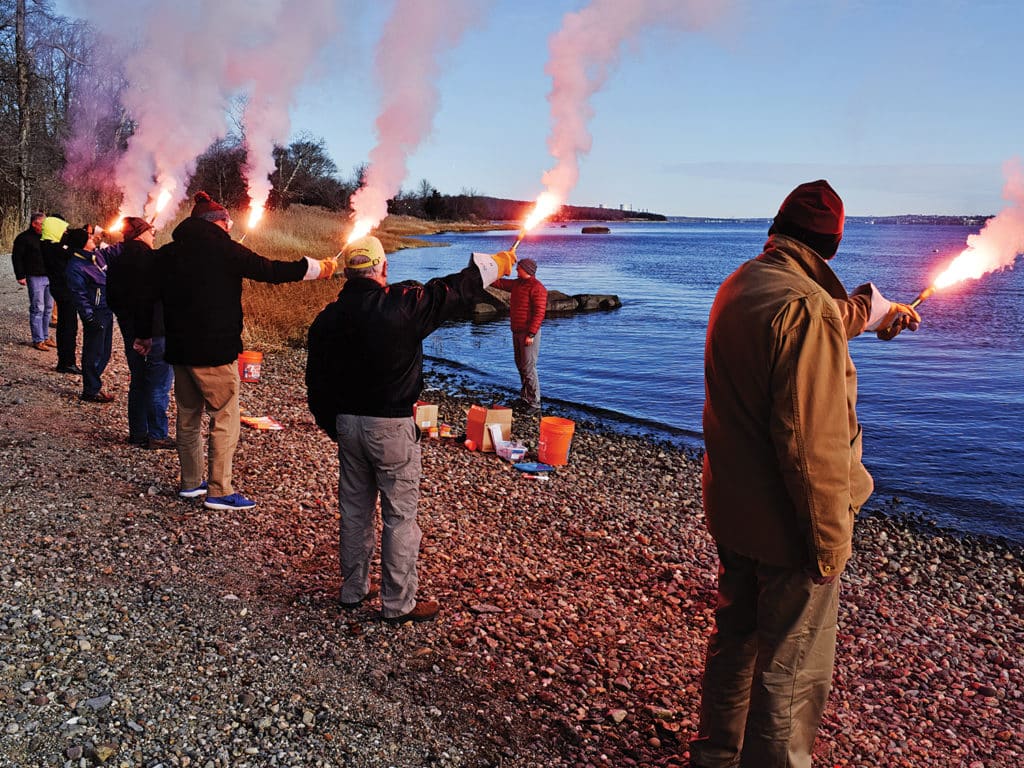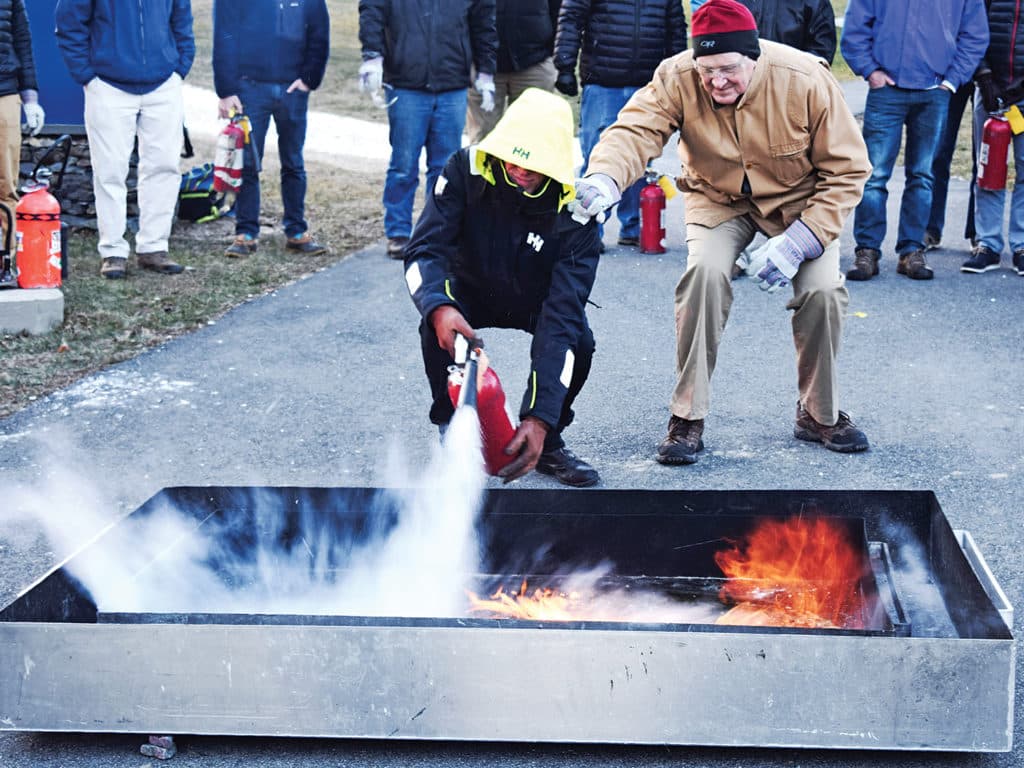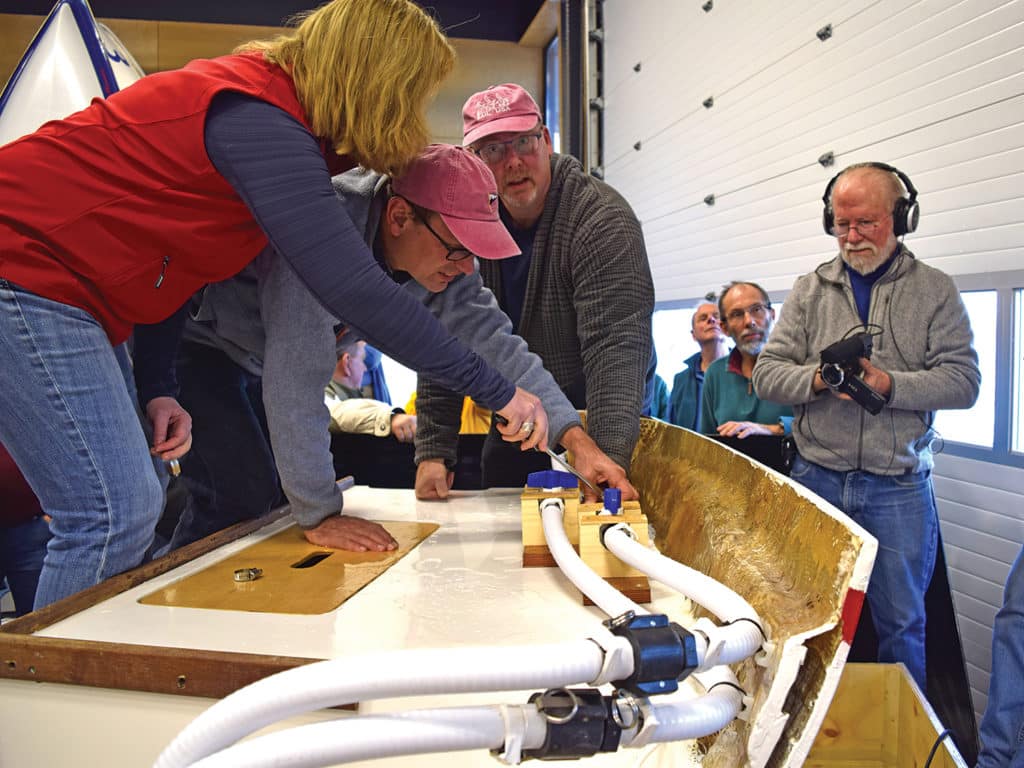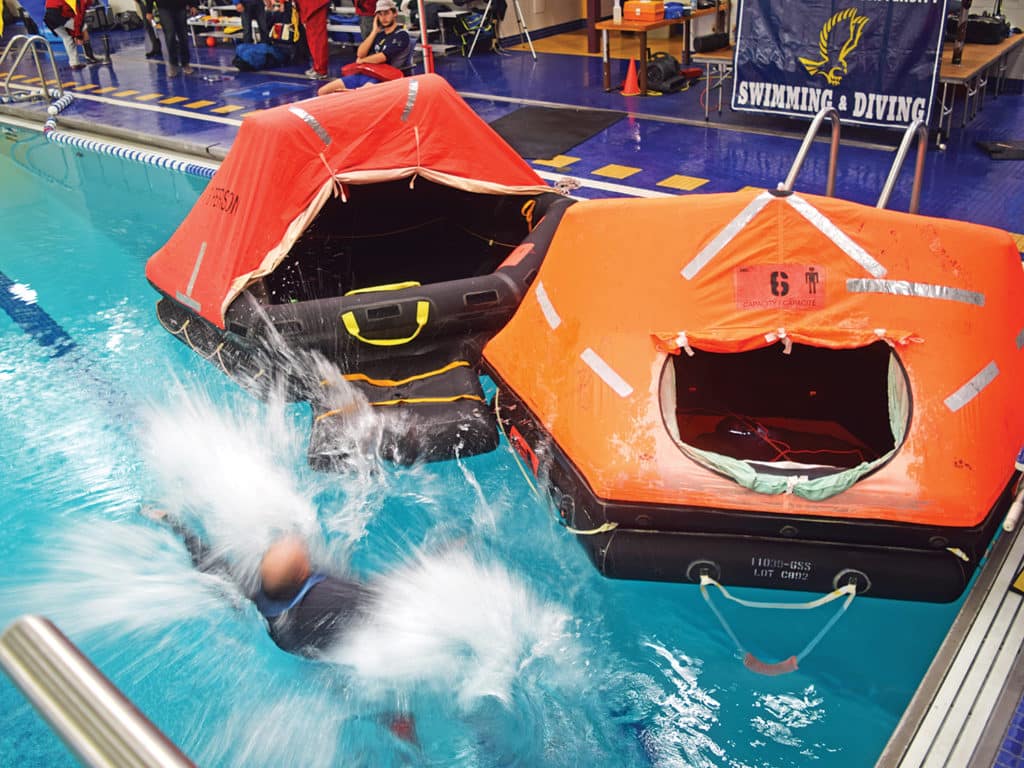
You’re 100 miles offshore, and a watch mate finds bilge water up over the floorboards. Is your boat leaking or flooding—and why, in this of all moments, do you care which it is?
This was just one of many high-stakes questions posed to some four dozen sailors in Rhode Island this past January at a daylong hands-on Safety at Sea seminar sponsored by the Cruising Club of America. Since the club would also sponsor the biennial Newport Bermuda Race the following June, and many folks in the room were either planning to take part in that event or make other imminent ocean passages, the presenters had our full attention.
For my part, I had attended several Safety at Sea seminars in the mid-1990s, and back then as a Cruising World staff editor, I’d even written and produced some of the handout texts. Recently, having purchased a 1988 Passport 40 with the idea of trans-Atlantic voyaging, I attended two separate SAS seminars over two years—both to update my own offshore skills and find out how the curriculum has evolved over two decades. In addition to January’s CCA seminar, I attended a 2017 Boston seminar sponsored by the Storm Trysail Club and the organizers of the Marion-Bermuda Race. Joining me for the CCA event was Lesley Davison, my partner in the Passport. Because Lesley is new to offshore sailing, it was instructive to observe how the latest SAS curriculum plays with someone newer to the learning curve.
Building a Body of Offshore Sailing Knowledge
The infamous 1979 Fastnet Race was a watershed event in offshore sailing (see “Touching the Water,” page 52). In that gathering of some 300 boats, 75 capsized and 24 were abandoned after a larger- than-forecast storm ripped through the fleet. Nineteen people died, 15 of them racing sailors and four spectators. In the aftermath of this and other ocean-sailing tragedies, experts have examined the facts and collectively reconsidered everything from yacht design to safety equipment to the knowledge possessed by offshore sailors. Today’s Safety at Sea Committee is organized by US Sailing (ussailing.org), the national governing body for the sport of sailing.

“The mission of the Safety at Sea Committee is to look after and try to improve the overall safety of offshore sailing,” said Chuck Hawley, a member of that committee and the on-screen talent for many of the US Sailing online instructional videos, which we’ll explore shortly. “Our goal is really to look at people who are taking their boats—which could be from about 20 to 100 feet—offshore for extended passages.” Recognizing that other organizations teach safety for powerboaters or dinghy sailors or inshore sailors, Hawley said: “In a sense, this is a more serious topic because we’re dealing with larger seas, bigger boats, larger crews. And we focus on trying to make it as safe as possible so those crews return.”
The Safety at Sea Committee divides its mission into two categories: regulation of equipment and education of sailors. To download a copy of the committee’s Safety Equipment Requirements, visit the US Sailing website.
On the education side, US Sailing offers certifications in three categories:
- Coastal Safety at Sea is intended for inland and coastal sailors. Course duration: four hours. Cost: $50 to $60.
- Offshore Safety at Sea, for crewmembers of offshore races, long-distance cruisers or any sailor wanting to improve on sailing skills. Course duration: eight hours. Cost: $125 to $175.
- International Offshore Safety at Sea with Hands-On Training, for crews involved in international offshore races or those requiring the International Offshore certificate that complies with World Sailing guidelines for Personal Safety, as well as for long-distance cruisers. Course duration: 14 hours. Cost: $300 to $400.
The certifications will matter most to racing sailors involved in sanctioned events that require a certain complement of each boat’s crew to show formal proof of their sailing knowledge. And while the certifications might matter less to cruising sailors—like me—still they are a worthy benchmark of knowledge gained.

US Sailing does not actually host Safety at Sea Seminars. Rather, it provides the curriculum and certification standards to local clubs and organizations, which are the hosts. Because the courses pack a lot of information into relatively short one- or two-day sessions, different clubs might emphasize different components of the curriculum. For example, the two-day Boston course I attended included segments on medicine and maintaining steering gear; the CCA course in Rhode Island featured an innovative leak simulator; a Storm Trysail-sponsored course in Long Island Sound this past May featured actual in-the-water crew-overboard recovery exercises; others bring in U.S. Coast Guard search-and-rescue crews and their helicopters to demonstrate abandon-ship procedures. If you plan to take a course, you might inquire about several being offered and find out exactly what topics each seminar will highlight.
Getting Down to the Nuts and Bolts
Several recent innovations in the SAS curriculum impressed me. The best of these is a new 10-chapter Online Offshore Safety at Sea Course. My experience with the two-day in-person courses is that so much distilled information comes so quickly, it’s like trying to drink from a fire hose—with hourlong topics ranging from heavy-weather sailing to emergency communications to abandon-ship practices to weather forecasting to first aid, any one of which deserves at least a day of its own. I brought a digital recorder to the Boston seminar, and kept notes with time stamps for topics I knew I wasn’t entirely grasping in real time and that I’d want to return to.
The online course does two things. First, it keeps the in-person hands-on seminar to a single day; if you’re traveling a distance, it saves the cost of an extra night of hotel rooms and meals. From the perspective of learning, the online course allows you to pause the video, or replay it as many times as necessary for you to fully understand the material. For such detailed instructions as how to repack an inflatable personal flotation device, this format allows you to stop each step and re-arm your own PFD along with the video. Assessments after each chapter allow you to check your comprehension. And a final exam (80 percent is required to pass) qualifies you for certification. The course takes about 10 hours to complete, roughly an hour per chapter.
By separating the more conceptual book knowledge from experiential hands-on knowledge—actually firing off flares, jumping into water dressed in full foul-weather gear and feeling an inflatable life vest go off, deploying a life raft and climbing into it with five other people, putting out real fires, and finding and stopping the sources of leaks (or flooding)—the most recent Safety at Sea online and in-person format has assembled the best mix of teaching tools I’ve found yet. It even changed my mind about a few things. For example, aboard my own boats, I had previously preferred the simple $100 West Marine combination inflatable PFD/harness to the $300 Spinlock Deckvest we carried aboard. But after getting into the water with both, the advantages of the Spinlock—much better buoyancy, better light and whistle, invaluable spray hood—were absolutely compelling. On the first business day after that experience, Lesley and I added a second Deckvest to our boat’s safety kit. Now it’s the only one I wear.

As for the question we posed at the top of this article—the difference between leaking and flooding—it matters because it determines whether your boat’s pumps can keep up with the water coming in. If they can keep up, you’re dealing with a leak; if they can’t, you’re dealing with flooding, and you’ll need to find and stop the cause as quickly as possible.
The Leak Trainer, created by Tom Barnhart and Mark Lenci for the CCA-sponsored seminar, gave sailors the chance to troubleshoot leaks and floods themselves, and to work through how to manage or stop each one. As with all the other direct experiences from this course, there’s simply no better substitute for solving high-stakes offshore-sailing problems with your own hands.
Tim Murphy and Lesley Davison have sailed their Passport 40, Billy Pilgrim, up the U.S. East Coast from Florida to Maine and look forward to sailing still farther east toward Europe.
Weather lessons
In fall 2018, the Cruising Club of America sponsored a daylong Weather and Sea State Analysis and Forecasting Symposium, featuring many veteran Safety at Sea presenters, who went into more far more detail than they might in a traditional SAS seminar. The club created a video series from that event—a wonderful resource that’s open to the public.
The series includes the following:
- Welcome
- Introduction
- Marine Weather Fundamentals
- The 500 mb Surface—Significance and Analysis
- Ocean Currents, Waves, and Sea State
- Forecasting—The Process and the Products
- Communication for Weather
- The Navigator’s Weather Watch
- Questions from the Floor
Resources
The following resources are part of the course material in a typical Safety at Sea Symposium.
- US Sailing: The national governing body for the sport of sailing, US Sailing provides the curriculum and the certification for Safety at Sea. Here you can find upcoming courses and a world of other resources.
- US Sailing Safety Equipment Requirements: Whether you’re racing or cruising, there’s an impressive body of knowledge and advice gathered in this document.
- Safety at Sea: A Guide to Safety Under Sail and Personal Survival, published by US Sailing: The primary illustrated text is sent out to SAS participants before a seminar. The book distills best practices associated with the following topics: Giving Assistance; Personal Safety Gear; Fire Safety; Crew Overboard Prevention and Recovery; Cold Exposure: On Deck and in the Water; Crew Health; Marine Weather and Waves; Heavy Weather; Storm Sails and Reefing; Damage Control and Jury Rigging; Search and Rescue; Signals; Emergency Communications; and Life Rafts and Abandoning Ship.
- Marine Medicine: A Comprehensive Guide, by Eric Weiss and Michael Jacobs: The latter is a frequent presenter at SAS programs. The book belongs aboard any boat sailing any distance from land.
- “A Guide to Steering Without a Rudder: Methods and Equipment Tested,” by Mike Keyworth: Recent data shows that the majority of crews who abandon their boats at sea do so because of a failed steering system. This method, presented both in a written document and series of videos, shows Mike Keyworth’s solution using headsail sheets run to port and starboard primary winches and a drogue trailed astern of his Swan 44, Chasseur. Interesting, at the January SAS seminar, the moderators discussed failures of this system aboard other boats in more recent events. The key, of course, is to actually work out the system that functions on your own boat.
- Landfall Navigation: Sponsors of many SAS programs, Landfall’s expert staff is typically on hand with advice on the latest marine safety equipment.








